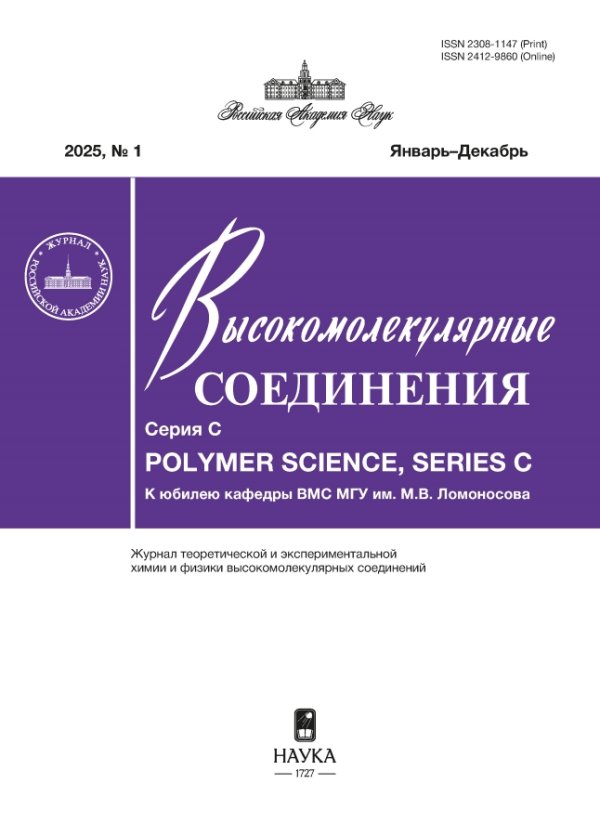Vol 65, No 1 (2023)
Articles
 3-4
3-4


Geometric Features of Structuring of Amphiphilic Macromolecules on the Surface of a Spherical Nanoparticle
Abstract
The self-assembly of amphiphilic homopolymers tightly grafted to the spherical nanoparticle and immersed in a selective solvent is studied by the computer experiment method. Conditions under which macromolecules form thin membrane-like layers surrounding the nanoparticle are determined. It is first shown that the emerging polymer structures may be approximated by complete embedded minimal surfaces satisfying the Weierstrass representation, namely, helicoid, catenoid, and Enneper and Costa surfaces. Mathematical constructions defining these minimal surfaces highlight a new type of ordering of polymer structures and determine its symmetry classification similar to crystal classification by Fedorov groups. Calculations for the two considered sets of parameters show that structures approximated by a helicoid are energetically more favorable than structures approximated by other minimal surfaces.
 5-13
5-13


The Rheological Behavior of Polymer Solution Threads
Abstract
Theoretical results of the authors in the field of the capillary thinning of polymer solution threads are reviewed. The dynamics of threads of both concentrated solutions without entanglements and dilute solutions, where hydrodynamic interactions play an important role, is considered. A molecular approach, in which macromolecules are simulated by a semiflexible chain, is used as a basis. This makes it possible to describe, from common positions, the nonlinear elasticity of solution and interactions taking into account the orientation of the chains. Particular attention is given to thread thinning in the region of the elastic behavior of solution where macromolecules unfold along the axis of stretching. The results of analysis of the capillary stability of a thread and conditions for solvent droplets emergence on its surface are presented, and the dynamics of formation of the hierarchical structure of beads-on-string droplets is viewed. Mechanisms behind the subsequent merging of droplets related to solvent overflow and droplets diffusion along the polymer string are discussed. The polymer string breakup occurs at time scales higher than the Rouse relaxation time of the polymer chain. String hardening and fiber formation may be an alternative.
 14-30
14-30


Elasticity of Highly Entangled Polymer Networks and Gels: Review of Models and Theory of Nonaffine Deformations
Abstract
The main models of phantom and topologically entangled polymer networks are surveyed. A theory of anisotropic and nonaffine deformation of both swollen and deswollen (with partial solvent removal) strongly entangled polymer networks in athermal and θ-solvents has been developed. It is shown that under weak anisotropic deformations of the deswollen network, the entanglement tube consists of fractal loopy globules. In a θ-solvent, slight deformations of the network lead to a decrease in the overlap of loopy globules without changing their sizes. Deformations of swollen networks, as well as strong deformations of deswollen networks, are described in terms of the slip-tube model. An effective Hamiltonian has been derived that determines the entropy of fractal loopy globules. Based on the Hamiltonian, it is shown that topological constraints can be described using the polymer–quantum diffusion analogy. The connection between topological and quantum entanglements is demonstrated.
 31-50
31-50


Dielectric Mismatch Effects on Polyelectrolyte Solutions in Electrified Nanopores: Insights from Mean-Field Theory
Abstract
We utilize the self-consistent field theory to explore the mechanical and electrical properties of charged surfaces immersed in polyelectrolyte solutions that could be potentially useful for electrochemical applications. Our research focuses on how the dielectric heterogeneity of the solution could affect the disjoining pressure and differential capacitance of the electric double layer. Relying on the developed theoretical framework, based on the Noether’s theorem, we calculate the stress tensor, containing the term, arising from the conformational entropy of the polymer chains. With its help we compute the disjoining pressure in polyelectrolyte solution confined between two parallel charged surfaces and analyze its behavior as a function of separation between the surfaces for different values of dielectric mismatch parameter. We also calculate the differential capacitance of the electric double layer and discuss how dielectric heterogeneity of the polyelectrolyte solution influences its values.
 51-58
51-58


Diblock Copolymer Melt in an Electric Field: Stability of the Homogeneous State in the Random Phase Approximation
Abstract
The contribution of I.Ya. Erukhimovich (1947–2022) to the creation of the theory of microphase separation in di- and triblock copolymers has been briefly analyzed. His matrix method of calculating correlation functions for multicomponent polymer systems has been applied to find the spinodal of a diblock copolymer melt in a static electric field. It has been strictly shown that for a linear dependence of local dielectric constant of the copolymer on the order parameter the spinodal condition remains the same as in the absence of the electric field. The correction to the critical value of the Flory‒Huggins parameter has been calculated for more general case of the quadratic dependence.
 59-66
59-66


Adsorption of Random Copolymer on a Chemically Heterogeneous Periodic Stripe-Patterned Surface
Abstract
The adsorption of a single random copolymer chain containing correlations in a sequence on the chemically heterogeneous periodic surface with the alternating striped texture is studied theoretically. The problem is solved within the framework of a partially directed walk polymer model in three dimensions using the generating functions approach and the annealed disorder approximation for averaging over the ensemble of random sequences of units in the copolymer. Dependences of the adsorption transition point on the composition of the random copolymer and the degree of correlation in the random sequence of units for various periodic surfaces are presented. It is shown that for compositionally symmetric and weakly symmetric surfaces there is the optimal composition of the random copolymer and the degree of correlation in the sequence of units, at which the inverse temperature corresponding to the adsorption transition point has a local minimum. In the case of the compositionally symmetric surface, the “optimal” random copolymer is also symmetric in composition. For surfaces with a pronounced composition asymmetry the best adsorbent is a homopolymer complementary to sites that prevail on the surface. The degree of asymmetry range, in which the dependence of the inverse transition temperature on the copolymer composition and the correlation parameter exhibits the local minimum, is fairly narrow.
 67-78
67-78


Polytope 240-Based Rod Structures Made of Tetrahedral Atoms: Comparison with Structures Obtained Using a Modular Design Method
Abstract
Some rod structures consisting of tetrahedral atoms and differing in symmetry are considered. The structures are obtained as a stereographic projection of polytope 240 vertices into three-dimensional Euclidean space when the polytope rolls along a straight line belonging to this space. The axes of the rod structures are the projections of great circles of a three-dimensional sphere containing the polytope 240 vertices. It has been shown that the rod structures obtained earlier by modular design are topologically equivalent to those considered in this paper, but they have a changed symmetry. Three possible conformations following from the results of this work are presented for a CnH2n hydrocarbon chain with close packing of atoms, conservation of the tetrahedral coordination of carbon atoms, and noncrystallographic symmetry.
 79-90
79-90


ИСТОРИЯ И ПЕРСПЕКТИВЫ АТОМИСТИЧЕСКОГО МОДЕЛИРОВАНИЯ ПОЛИСАХАРИДОВ
Abstract
Представлены история и перспективы развития потенциалов межатомного взаимодействия для моделирования молекулярных систем и, в частности, полисахаридов. Рассмотрены популярные семейства потенциалов, такие как CHARMM, GROMOS, AMBER и OPLS. Обозначены проблемы применимости данных моделей для мономеров сахаров: плохая воспроизводимость экспериментальных свойств и гиперагрегация при малых концентрациях. Также рассмотрены векторы развития данной области: модификация невалентных взаимодействий в потенциале и использование поляризуемых потенциалов. Продемонстрированы примеры применения атомистического моделирования полисахаридов в актуальных фундаментальных и промышленных задачах на примере целлюлозы. Приведены важные вычислительные работы, внесшие существенный вклад в понимание структуры и процессов, происходящих в кристалле целлюлозы. Кроме того, дан обзор доступных на сегодня масштабов времен и характерных размеров систем для моделирования в пакетах GROMACS, LAMMPS, OpenMM и AMBER для модели раствора сахарозы.
 91-109
91-109


Effect of Characteristics of Polymer Microgel Catalysts on the Efficiency of Interfacial Catalysis
Abstract
Effect of the architecture and composition of a hydrophilic microgel catalyst on the rate of interfacial catalytic reaction proceeding at the water/oil interface and involving reagents dissolved in opposite phases is studied using dissipative particle dynamics simulations. It is shown that a decrease in the crosslinking density of the microgel, the existence of a cavity in its architecture, an increase in its size, the incorporation the hydrophobic comonomers into a macromolecule, and a rise in the degree of solubility of a network macromolecule in oil contribute to acceleration of the catalytic reaction due to increase of the area of the water–oil–microgel contact and growth of the number of contacts between reagents and catalytic groups. However, in the case of amphiphilic microgels and microgels soluble in both phases, the acceleration of the reaction is restrained by a low rate of reagents diffusion and a rapid reduction in the concentration of reagents in the vicinity of catalytic sites.
 110-121
110-121


Stimuli-Responsive Systems Based on Polymer-like Wormlike Micelles of Ionic Surfactants and Their Modern Applications
Abstract
Solutions based on polymer-like micelles of ionic surfactants attract the attention of scientists as stimuli-responsive systems that can transform from a low-viscosity Newtonian fluid to a viscoelastic solution having a viscosity of up to 10 kPa s and an elastic response. The shape of micelles and their length are determined by the balance of hydrophobic and electrostatic interactions; therefore, the use of various low molecular weight substances or functional nanoparticles as additives can significantly change the rheological properties of such solutions and impart new stimuli-responsive properties to them. This review presents the most commonly used methods for controlling the properties of multicomponent solutions of wormlike surfactant micelles, including nanocomposite systems. Modern areas of practical application of such systems and prospects for their development are described.
 122-137
122-137


Study of the Effect of Nonselective Organic Solvent Nature on the Self-Organization of Amphiphilic Block Copolymers of D,L-Lactide and Ethylene Oxide in Aqueous Solution
Abstract
The self-organization of biocompatible amphiphilic block copolymers of D,L-lactide and ethylene oxide with various hydrophobic poly(D,L-lactide) block length in aqueous media has been investigated. It has been shown that the nature of nonselective organic solvent has a considerable effect on the size, size polydispersity, and morphology of micelles of a block copolymer with a long poly(D,L-lactide) block. To elucidate the dependence of properties of block copolymer micelles on the common organic solvent type (acetone, tetrahydrofuran, N,N-dimethylformamide, and acetonitrile) various parameters of the used solvents have been estimated, and correlation between the Flory–Huggins coefficient and the surface tension between the hydrophobic block and the nonselective organic solvent and the parameters of micellar structures has been found.
 138-152
138-152












